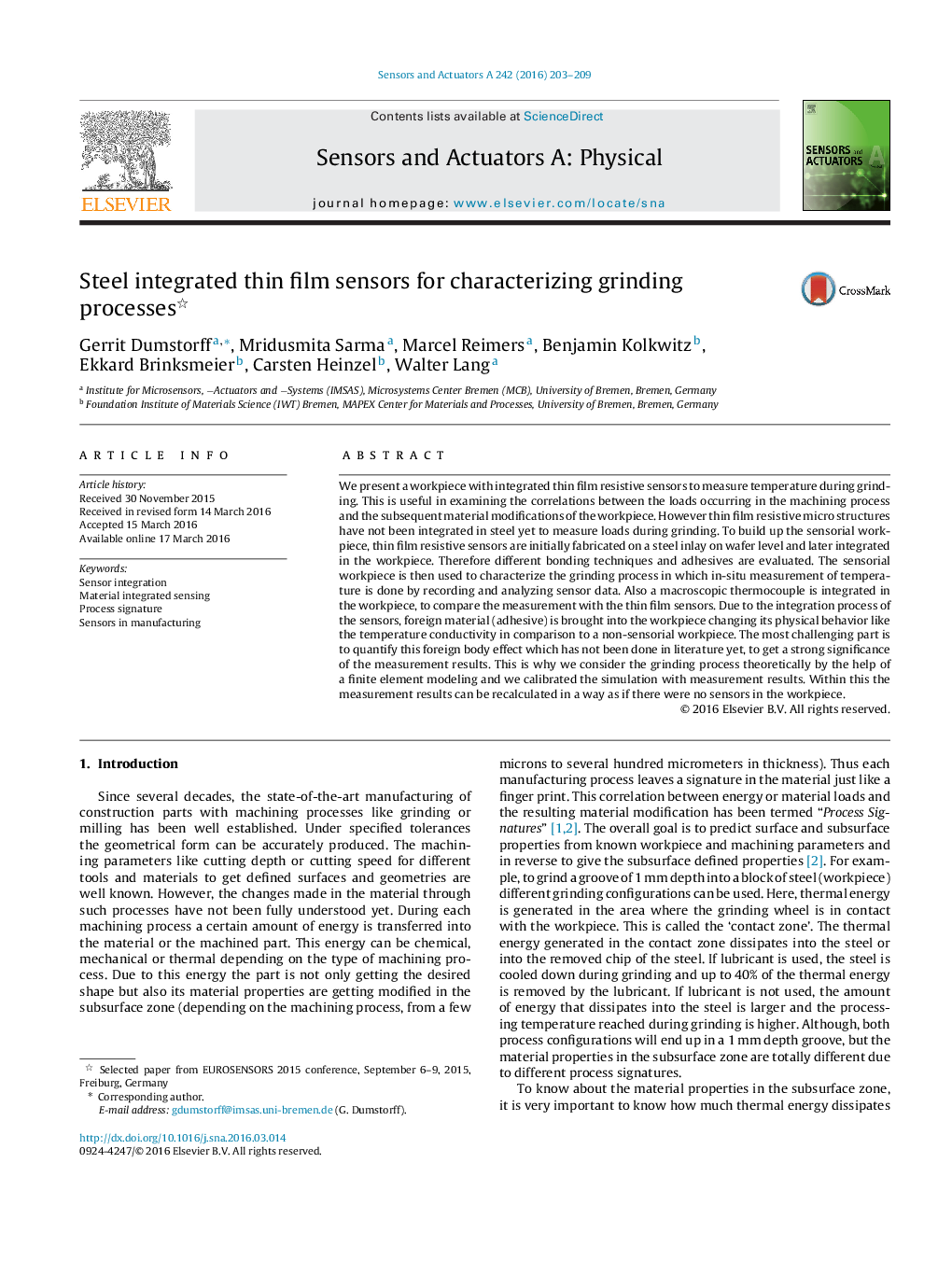| کد مقاله | کد نشریه | سال انتشار | مقاله انگلیسی | نسخه تمام متن |
|---|---|---|---|---|
| 7135047 | 1461858 | 2016 | 7 صفحه PDF | دانلود رایگان |
عنوان انگلیسی مقاله ISI
Steel integrated thin film sensors for characterizing grinding processes
ترجمه فارسی عنوان
سنسورهای فیلم نازک نوری برای توصیف فرآیند آسیاب کردن
دانلود مقاله + سفارش ترجمه
دانلود مقاله ISI انگلیسی
رایگان برای ایرانیان
کلمات کلیدی
یکپارچه سازی سنسور، مواد حساس یکپارچه، امضای فرآیند، سنسورهای تولید،
ترجمه چکیده
ما در حال حاضر یک قطعه کار با سنسورهای مقاوم در برابر فیلم نازک یکپارچه برای اندازه گیری درجه حرارت در هنگام سنگ زنی. این در بررسی رابطه بین بارهای رخ داده در فرایند ماشینکاری و تغییرات مواد بعدی قطعات قطعه مفید است. با این حال، میکرو سازه های مقاوم در برابر فیلم های نازک هنوز در فولاد برای اندازه گیری بار در هنگام سنگ زنی ساخته نشده اند. برای ساختن قطعه سنسوری، سنسورهای مقاومتی فیلم نازک در ابتدا بر روی یک ورقه فولادی روی سطح ویفر ساخته می شوند و بعدا در قطعه کار قرار می گیرند. بنابراین تکنیک های مختلف پیوند و چسب ها مورد ارزیابی قرار می گیرند. سپس قطعه سنسورها برای مشخص کردن روند آسیاب کردن که در آن اندازه گیری دما در محل با ضبط و تجزیه و تحلیل داده های سنسور انجام می شود استفاده می شود. همچنین یک ترموکوپل ماکروسکوپی در قطعه کار یکپارچه شده است، برای مقایسه اندازه گیری با حسگرهای فیلم نازک. با توجه به فرآیند ادغام سنسورها، مواد خارجی (چسب) به قطعه کار تبدیل می شود که رفتار فیزیکی آن مانند هدایت دما را نسبت به یک قطعه غیر حساسیتی تغییر می دهد. بخش چالش برانگیز این است که این اثر خارجی خارجی را اندازه گیری کند که هنوز در ادبیات انجام نشده است، تا اهمیت قاطع نتایج اندازه گیری را بدست آورد. به همین دلیل است که ما با استفاده از مدل سازی عناصر محدود، ما را به لحاظ نظری از روند پردازش در نظر می گیریم و شبیه سازی را با نتایج اندازه گیری کالیبراسیون کردیم. در این حالت می توان نتایج اندازه گیری را به گونه ای محاسبه کرد که اگر در قطعه کار هیچ سنسور وجود نداشته باشد.
موضوعات مرتبط
مهندسی و علوم پایه
شیمی
الکتروشیمی
چکیده انگلیسی
We present a workpiece with integrated thin film resistive sensors to measure temperature during grinding. This is useful in examining the correlations between the loads occurring in the machining process and the subsequent material modifications of the workpiece. However thin film resistive micro structures have not been integrated in steel yet to measure loads during grinding. To build up the sensorial workpiece, thin film resistive sensors are initially fabricated on a steel inlay on wafer level and later integrated in the workpiece. Therefore different bonding techniques and adhesives are evaluated. The sensorial workpiece is then used to characterize the grinding process in which in-situ measurement of temperature is done by recording and analyzing sensor data. Also a macroscopic thermocouple is integrated in the workpiece, to compare the measurement with the thin film sensors. Due to the integration process of the sensors, foreign material (adhesive) is brought into the workpiece changing its physical behavior like the temperature conductivity in comparison to a non-sensorial workpiece. The most challenging part is to quantify this foreign body effect which has not been done in literature yet, to get a strong significance of the measurement results. This is why we consider the grinding process theoretically by the help of a finite element modeling and we calibrated the simulation with measurement results. Within this the measurement results can be recalculated in a way as if there were no sensors in the workpiece.
ناشر
Database: Elsevier - ScienceDirect (ساینس دایرکت)
Journal: Sensors and Actuators A: Physical - Volume 242, 1 May 2016, Pages 203-209
Journal: Sensors and Actuators A: Physical - Volume 242, 1 May 2016, Pages 203-209
نویسندگان
Gerrit Dumstorff, Mridusmita Sarma, Marcel Reimers, Benjamin Kolkwitz, Ekkard Brinksmeier, Carsten Heinzel, Walter Lang,
